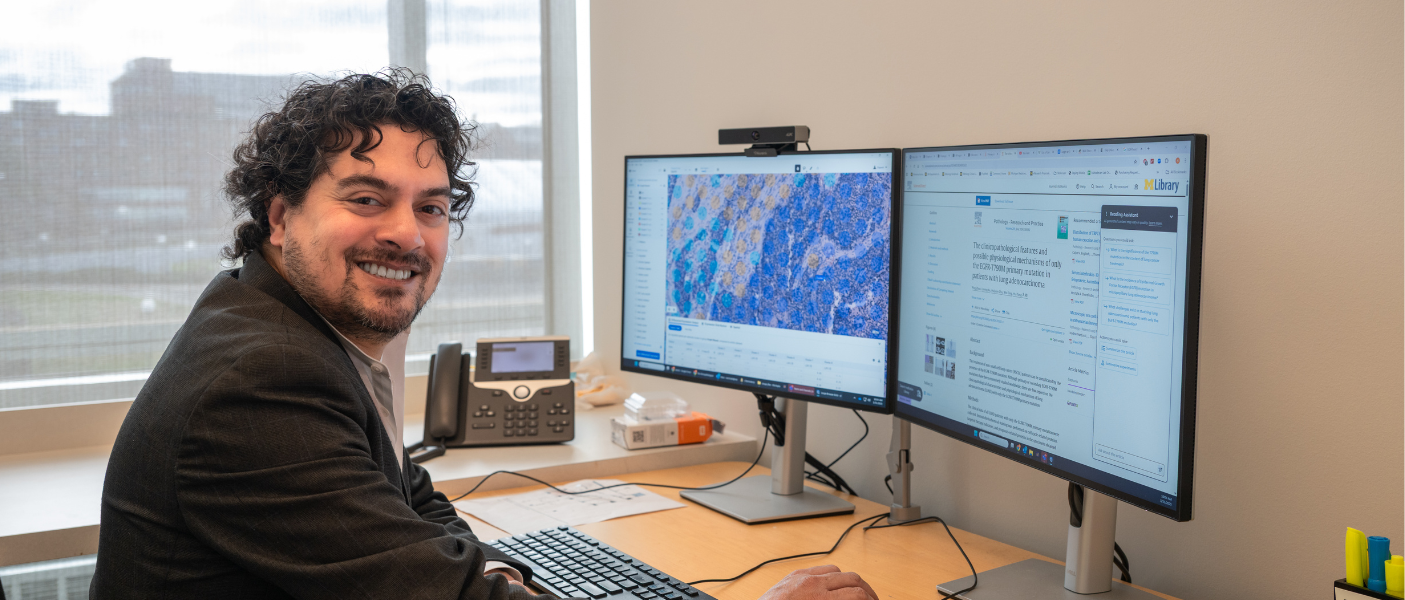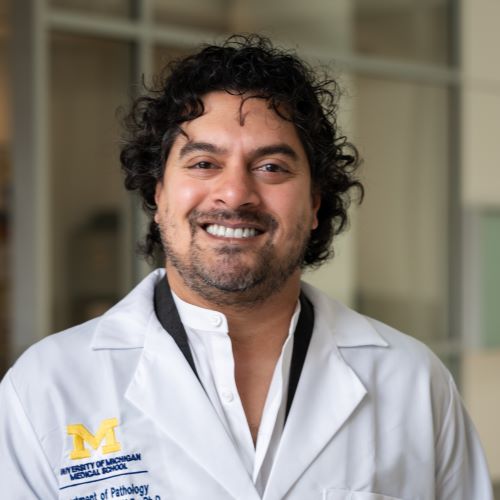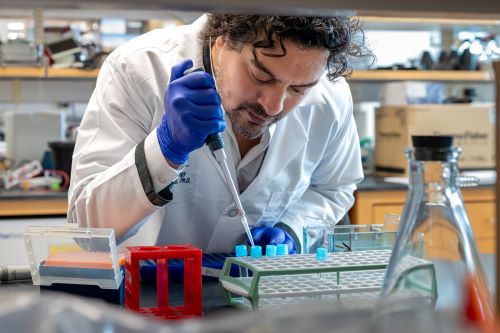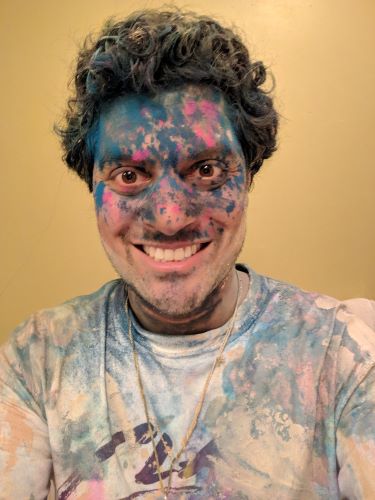

 The world seems to shrink with each passing year. A man from southern India and a woman from Fiji met and married in San Francisco, California, where their first son, Navin, was born. This young family soon relocated to Basel, Switzerland, for Navin’s mother’s postdoctoral fellowship. Five years later, they returned to the United States, settling in New Carrollton, Maryland. The father became an English professor at Howard University, while the mother took a position as a molecular biologist at the NIH. Today, their son, Navin R. Mahadevan, MD, PhD, is an assistant professor of pathology at Michigan Medicine.
The world seems to shrink with each passing year. A man from southern India and a woman from Fiji met and married in San Francisco, California, where their first son, Navin, was born. This young family soon relocated to Basel, Switzerland, for Navin’s mother’s postdoctoral fellowship. Five years later, they returned to the United States, settling in New Carrollton, Maryland. The father became an English professor at Howard University, while the mother took a position as a molecular biologist at the NIH. Today, their son, Navin R. Mahadevan, MD, PhD, is an assistant professor of pathology at Michigan Medicine.
“I became interested in science under my mom's influence,” reports Mahadevan. “My brother and I split our parents’ passions equally. My brother is a writer and teacher, following in my father's footsteps, and I pursued a career in the sciences. As I grew up, I knew I was interested in basic research, but I chose to attend medical school because it would enable me to help people and ask more informed scientific questions relevant to humans.” Mahadevan attended medical school at the University of California, San Diego, where he also obtained a PhD. In his second year of medical school, he was introduced to the field of Pathology. “It was comfortable to me. It involved looking through a microscope, which I had already been doing for years at this point while conducting more basic research.” As he considered the MD/PhD career path, he recalls thinking, “This is going to be like doing a second MD and PhD.” The residency and fellowship were akin to earning another MD in terms of time and content, and the postdoctoral fellowship was comparable to earning a second PhD.
During his undergraduate training at Washington University in St Louis, Mahadevan had worked in the research laboratory of Dr. Jeremy Gibson-Brown, where he focused on an animal called Amphioxus, which is the invertebrate most closely related to vertebrates. “In this lab, I studied its body plan by examining it under the microscope and cutting sections, as is done in pathology.” Then, after graduation, he went to Australia as a Fulbright scholar, where he did stem cell research in the laboratory of Dr. Martin Pera at Monash University in Melbourne. He learned how to culture cells and evaluate cell growth under a microscope. By the time he was introduced to pathology in medical school, the laboratory had become a familiar and comfortable home. “Pathology is a unifying discipline of medicine. It can unite the patient’s medical history, radiographs, and pathologic findings to explain everything from the patient’s symptoms to how the disease might progress and what therapy a patient should get. It is foundational to medicine.”
His next stop was Brigham and Women’s Hospital for an anatomic pathology residency and a fellowship in molecular and genetic pathology. During this time, he had an opportunity to rotate through each of the hospitals affiliated with Harvard University, including Children’s Hospital, Beth Israel, and Massachusetts General Hospital. Then, it was time to return to his research roots for his postdoctoral fellowship, which was completed in the laboratory of Dr. David Barbie, director of the Lowe Center for Thoracic Oncology at the Dana-Farber Cancer Institute.
The research work Mahadevan completed in the Barbie lab focused on small-cell lung cancer and became the foundation for his research career. “I investigated how the immune system recognizes and responds to this specific type of lung cancer. This is a very aggressive cancer with a very low 2-year survival rate. What I discovered is that this cancer can evade detection by the immune system through a regulatory mechanism known as epigenetics.” The tumor is not mutating the DNA itself. Instead, it places certain regulatory marks on the DNA that silence gene transcription. Those genes that are silenced are the ones that control the presentation of antigens, which is how the immune system recognizes cells. He discovered that in 70-75% of small-cell lung cancers, MHC-I is silenced. However, about 15% of small cell lung cancers epigenetically reactivate this mechanism of immune recognition, and these may be amenable to the immunotherapies that have revolutionized cancer care in the last five years, meaning these patients could have a durable response to immunotherapy, extending their lives by years.
 Mahadevan completed his postdoctoral fellowship and was recruited to the University of Michigan Medical School Department of Pathology in October 2024. He is currently setting up his laboratory and is focused on hiring personnel to work in it. “The work I want to do here is more basic in nature, involving tissue culture and wet lab techniques. However, something I’m quite excited about that brings my pathology background into it is trying to find evidence of these mechanisms in patient samples. That is something I am uniquely equipped to do, and the environment here at Michigan supports this kind of translational research.” He will utilize the diagnostic expertise at the University of Michigan's Department of Pathology to select patient specimens for his research. “This is one of the most critical aspects. If the diagnosis is incorrect, the data will also be incorrect. You must be absolutely sure of the diagnosis, and the diagnostic pathology skills of the pathologists here will ensure that I have the correct specimens for my research.” Once he has his specimens, he will subject them to assays such as multiplexed immunofluorescence, which allows for the detection of multiple proteins expressed on any of the cells in the tissue section. Another technique he will use is spatial transcriptomics, which enables the interrogation of all genes expressed in all cells within the tissue sample while retaining the spatial context.
Mahadevan completed his postdoctoral fellowship and was recruited to the University of Michigan Medical School Department of Pathology in October 2024. He is currently setting up his laboratory and is focused on hiring personnel to work in it. “The work I want to do here is more basic in nature, involving tissue culture and wet lab techniques. However, something I’m quite excited about that brings my pathology background into it is trying to find evidence of these mechanisms in patient samples. That is something I am uniquely equipped to do, and the environment here at Michigan supports this kind of translational research.” He will utilize the diagnostic expertise at the University of Michigan's Department of Pathology to select patient specimens for his research. “This is one of the most critical aspects. If the diagnosis is incorrect, the data will also be incorrect. You must be absolutely sure of the diagnosis, and the diagnostic pathology skills of the pathologists here will ensure that I have the correct specimens for my research.” Once he has his specimens, he will subject them to assays such as multiplexed immunofluorescence, which allows for the detection of multiple proteins expressed on any of the cells in the tissue section. Another technique he will use is spatial transcriptomics, which enables the interrogation of all genes expressed in all cells within the tissue sample while retaining the spatial context.
One fascinating aspect of Mahadevan’s research, which carries a slightly higher risk but may have broader implications, is the investigation of reactivated antigens that act as flags recognized by the immune system. “We don’t know what they are, but there is early evidence that this epigenetic mechanism, which derepresses antigen presentation by turning genes on, is not only affecting the genes that enable tumor antigen presentation but also other genes in the genome that are typically silent. You are essentially rewriting your transcriptome or your gene expression.” The genes that may be being turned on could be derived from retroviruses that infected humans long ago in evolutionary time and have remained dormant in the genome. If we could reactivate these genes, we could program our immune system and/or CAR-T cells, killer T-cells, to target them and fight the disease.”
In addition to his research, Mahadevan provides molecular diagnostic clinical services for about 20% of his time. Unlike other areas of pathology, molecular diagnostics is tissue agnostic; the specialty has not subspecialized by organ or diagnosis. “The philosophy is a gene is a gene is a gene.” Regardless of the type of cancer in which the mutated gene is discovered, it will likely respond similarly. This means that molecular genetic pathologists must understand the biology and clinical implications of these mutations across a wide variety of tumors. “This allows me to stay current with the latest advances in anatomic pathology, as many of these molecular alterations are used for the diagnosis of specific tumor types.”
Mahadevan’s number one short-term goal is to establish his lab and begin training personnel within it. “Aside from conducting the actual experimentation and data analysis, one thing I truly enjoy doing is training postdoctoral researchers and students.” To this end, he recently added his name as a mentor for students in the Molecular and Cellular Pathology graduate program. He is also looking for some summer students at the high school or undergraduate level who he can introduce to scientific exploration. Additionally, he will focus on publishing his research and applying for grants to ensure the long-term sustainability of his lab.
 On a personal note, he is looking forward to exploring Ann Arbor and the state of Michigan. Recently, he discovered the Detroit Institute of Art, “I started on the third floor and worked my way down. I purposely skipped the first floor because I am determined to go back. It is an amazing museum. I really enjoyed it!” He added, “In addition to exploring, I enjoy cooking. I love to cook with others and for others. I look forward to making big dinners for whoever wants it.” When asked for any fun facts about himself, he volunteered, “I was born quite premature, at 26 weeks – that is about 6.5 months. I also danced the road at Carnival in Trinidad. I love to travel, and I enjoy classical music, especially opera.” He then added that he had studied Spanish from elementary school through high school and was almost fluent by the time he entered college. Instead of continuing in college, he switched to Italian, as he loved to read the lyrics of Italian operas. “At the end of medical school, I spent about six months working in a lab in Italy. During my research, they would speak to me in Italian, and I would reply in English to be sure I understood correctly. My Italian improved exponentially while I was there.”
On a personal note, he is looking forward to exploring Ann Arbor and the state of Michigan. Recently, he discovered the Detroit Institute of Art, “I started on the third floor and worked my way down. I purposely skipped the first floor because I am determined to go back. It is an amazing museum. I really enjoyed it!” He added, “In addition to exploring, I enjoy cooking. I love to cook with others and for others. I look forward to making big dinners for whoever wants it.” When asked for any fun facts about himself, he volunteered, “I was born quite premature, at 26 weeks – that is about 6.5 months. I also danced the road at Carnival in Trinidad. I love to travel, and I enjoy classical music, especially opera.” He then added that he had studied Spanish from elementary school through high school and was almost fluent by the time he entered college. Instead of continuing in college, he switched to Italian, as he loved to read the lyrics of Italian operas. “At the end of medical school, I spent about six months working in a lab in Italy. During my research, they would speak to me in Italian, and I would reply in English to be sure I understood correctly. My Italian improved exponentially while I was there.”
Dr. Navin Mahadevan has several fascinating facets to his life and personality. Be sure to stop by and welcome him if you haven't already done so. You may find a friend and colleague with whom to share adventures, dinner, or a night out at the opera.